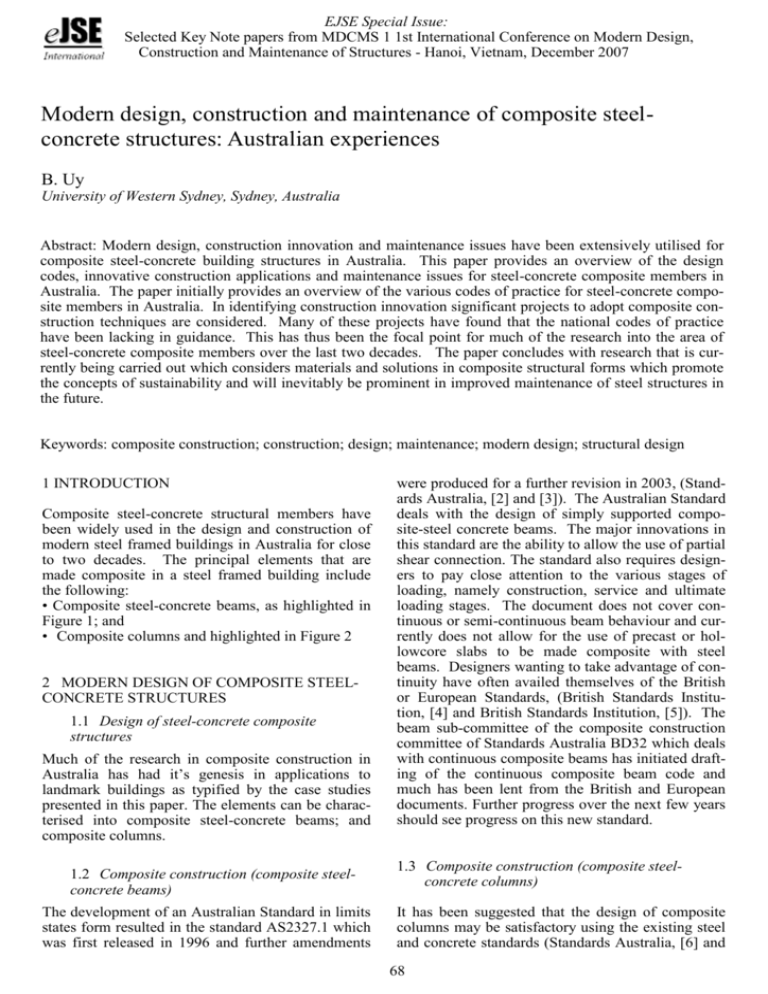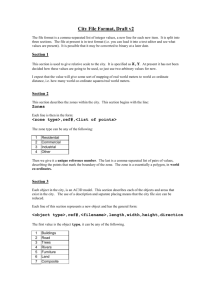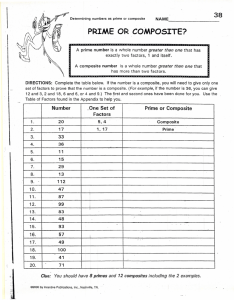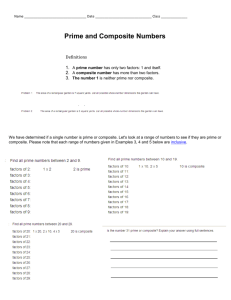Uy B 2008 - Electronic Journal of Structural Engineering
advertisement

EJSE Special Issue: Selected Key Note papers from MDCMS 1 1st International Conference on Modern Design, Construction and Maintenance of Structures - Hanoi, Vietnam, December 2007 Modern design, construction and maintenance of composite steelconcrete structures: Australian experiences B. Uy University of Western Sydney, Sydney, Australia Abstract: Modern design, construction innovation and maintenance issues have been extensively utilised for composite steel-concrete building structures in Australia. This paper provides an overview of the design codes, innovative construction applications and maintenance issues for steel-concrete composite members in Australia. The paper initially provides an overview of the various codes of practice for steel-concrete composite members in Australia. In identifying construction innovation significant projects to adopt composite construction techniques are considered. Many of these projects have found that the national codes of practice have been lacking in guidance. This has thus been the focal point for much of the research into the area of steel-concrete composite members over the last two decades. The paper concludes with research that is currently being carried out which considers materials and solutions in composite structural forms which promote the concepts of sustainability and will inevitably be prominent in improved maintenance of steel structures in the future. Keywords: composite construction; construction; design; maintenance; modern design; structural design 1 INTRODUCTION Composite steel-concrete structural members have been widely used in the design and construction of modern steel framed buildings in Australia for close to two decades. The principal elements that are made composite in a steel framed building include the following: • Composite steel-concrete beams, as highlighted in Figure 1; and • Composite columns and highlighted in Figure 2 2 MODERN DESIGN OF COMPOSITE STEELCONCRETE STRUCTURES 1.1 Design of steel-concrete composite structures Much of the research in composite construction in Australia has had it’s genesis in applications to landmark buildings as typified by the case studies presented in this paper. The elements can be characterised into composite steel-concrete beams; and composite columns. 1.2 Composite construction (composite steelconcrete beams) The development of an Australian Standard in limits states form resulted in the standard AS2327.1 which was first released in 1996 and further amendments were produced for a further revision in 2003, (Standards Australia, [2] and [3]). The Australian Standard deals with the design of simply supported composite-steel concrete beams. The major innovations in this standard are the ability to allow the use of partial shear connection. The standard also requires designers to pay close attention to the various stages of loading, namely construction, service and ultimate loading stages. The document does not cover continuous or semi-continuous beam behaviour and currently does not allow for the use of precast or hollowcore slabs to be made composite with steel beams. Designers wanting to take advantage of continuity have often availed themselves of the British or European Standards, (British Standards Institution, [4] and British Standards Institution, [5]). The beam sub-committee of the composite construction committee of Standards Australia BD32 which deals with continuous composite beams has initiated drafting of the continuous composite beam code and much has been lent from the British and European documents. Further progress over the next few years should see progress on this new standard. 1.3 Composite construction (composite steelconcrete columns) It has been suggested that the design of composite columns may be satisfactory using the existing steel and concrete standards (Standards Australia, [6] and 68 EJSE Special Issue: Selected Key Note papers from MDCMS 1 1st International Conference on Modern Design, Construction and Maintenance of Structures - Hanoi, Vietnam, December 2007 Standards Australia, [7]), however this has some serious drawbacks. The benefits of this type of column are through savings made during the construction phase and thus these need to be considered. The Australian steel standard allows one to use a rational local buckling method to determine the local buckling coefficient however and this is useful. However the concrete standard will not allow for confinement if it is required to be taken into account for large plate thicknesses. The deficiencies of these codes have been resolved in the AS5100 Bridge design series which was produced by committee BD90 which was a partnership between Standards Austra- lia, the Australasian Railway Association and AUSTROADS. The Standard deals with the design of members in steel and composite construction, [8]. The standard draws heavily on the Australian Standards, AS4100-1998 and AS2327.1-2003 (Standards Australia, [6] and Standards Australia, [2]) for beam and column design. The standard is also however also able to deal with composite construction members which may prove to be a forerunner to the development of a standard for composite columns produced by BD32 for buildings. 2 CONSTRUCTION OF COMPOSITE STEELCONCRETE STRUCTURES 2.1 Grosvenor Place, Sydney The Grosvenor Place building is a landmark building on George Street, Sydney (Figure 5) which is on Fig. 1. Composite beam types used in modern steel framed building structures, [1] 69 EJSE Special Issue: Selected Key Note papers from MDCMS 1 1st International Conference on Modern Design, Construction and Maintenance of Structures - Hanoi, Vietnam, December 2007 the border of the financial and rocks districts. The building has a total height of 180 metres with 44 storeys above ground. The building was designed by the structural engineers, Ove Arup and Partners and construction was completed in 1988 by Concrete Constructions, [9]. The innovative use of structural steel in this building included quite a few firsts in Australia. The building involved the use of high strength cold formed profiled steel sheets for the decking. The beams which span approximately 16 metres from reinforced concrete core to perimeter frame were designed for serviceability as semicontinuous, with a semi-rigid joint assumed between the beam and core. The columns in the lower levels of the buildings are quite unique and involve three perimeter columns being grouped at the ground level in a single column, with the key objective being the savings in space made for car parking in the basement. This involved the use of high strength quenched and tempered structural steel being used for encased sections in this zone. 2.2 Star City, Sydney The Star City Casino building in Sydney was completed in 1995, (Figure 6). Upon completion it was the largest building project in Sydney since the construction of the Sydney Opera House. The building was designed by structural engineers Ove Arup and Partners and built by Leighton Contractors. The project entailed a massive podium structure of casino, theatres, shopping and other facilities with a total floor area in a single plate exceeding seven football fields, King, [10]. The podium was then capped with two twenty storey towers. One tower being for a hotel and the other being for a residential apartment facility. The building comprised a number of innovative composite construction and high strength steel applications. Firstly, in the main gaming areasof the casino, large span composite beams of approximately 16 metres were designed and constructed. In the basement levels of the building, high strength steel fabricated sections were used to miminise the cross-sections of the columns, Davie, [11]. Another very innovative structural steel application concerned the roofs of the Lyric and Showroom theatres. Due to constraints with site access Fig. 2 Composite column forms used in modern steel framed building structures, 1. Fig. 4 AS5100.6-2004 Bridge design, part 6 Steel and composite construction, 8. Fig. 3 AS2327.1-2003 Composite structures: simply supported beams, 3. 70 EJSE Special Issue: Selected Key Note papers from MDCMS 1 1st International Conference on Modern Design, Construction and Maintenance of Structures - Hanoi, Vietnam, December 2007 for craneage, the trusses for the roofs had to be of minimal weight. This required the design of 36 metre spanning trusses made composite with a topping slab and using high strength structural steel for the sections. Post-tensioning of the trusses helped to alleviate long-term serviceability concerns. 2.3 Latitude, Sydney The Latitude building in Sydney has been completed in 2005 and exists on George Street on the World Square Site and is directly adjacent to Sydney’s Chinatown at Haymarket as illustrated in Figure 7. The building is a landmark building which was designed by Hyder Consulting and constructed by Multiplex. The building has a total height of 222 m over 45 floors and has some very innovative features in it’s design. The beams in the floor system span a total of 14 metres from core to perimeter frame and in order to achieve this the beam’s were pre-cambered by 40 mm to overcome estimated long term deflections of 60 mm. The building also uses twin composite columns on the perimeter frame, using 508 mm diameter steel tubes filled with 80 MPa concrete. The building has required the design of 7 metre deep transfer trusses using large diameter steel tubes filled with concrete and large high strength steel boxes filled with concrete, (Chaseling, [12] and Australian Steel Institute, [13]). 3 MAINTENANCE OF COMPOSITE STEELCONCRETE STRUCTURES 3.1 Sustainable solutions for steel-concrete composite structures Future applications of steel-concrete composite structures will inevitably need to consider sustainability issues. The International Association of Fig. 5 Grosvenor Place, Sydney 1988 9. Fig. 6 Star City, Sydney, 10. Fig. 8 City Hall London, 2002 16. Fig. 7 Latitude, Sydney, 2005 12. 71 EJSE Special Issue: Selected Key Note papers from MDCMS 1 1st International Conference on Modern Design, Construction and Maintenance of Structures - Hanoi, Vietnam, December 2007 Bridge and Structural Engineers released a special issue of Structural Engineering International devoted to sustainable engineering. In this issue, it is made clear that sustainable construction will need to involve five phases in the design of a building, Maydl [14]. These five phases include: • Project development; • Planning; • Construction; • Operation/maintenance; and • Removal There has also been worldwide moves to see energy efficient buildings considered. Warburton and Kostura [15] presented the approaches being used in the USA and the EU to promote energy efficiency in buildings. In Australia the National Australian Built Environment Rating System has developed an Australian Building Greenhouse rating. 3.2 Sustainability issues in steel-concrete composite structures A landmark building on the world stage in terms of energy efficiency was the City Hall, London completed in July 2002, (shown in Figure 8), [16]. The key sustainability features included in this building included: • Steel diagrid support structure which acts as a giant radiator • Major tubular members filled with hot water to act as a discrete heater; and • Chilled beams to provide air conditioning. In Australia the first building to receive a five star Australian Building Greenhouse Rating (ABGR) was the 30 Bond Street building at Hickson Road, Sydney completed in early 2004. This building also used chilled beam technology, [17]. A more recent example of a building to try to achieve a five star green rating in Australia, included the Number 2 Market Street Sydney building, [18]. 3.3 The use of high performance steels in composite steel-concrete structures In addition to services, sustainability principles in structural engineering can be further influenced by the use of new innovative materials which have high performance qualities. Uy [18] has already outlined the potential benefits for strength, stability and ductility of high performance steel sections filled with concrete. In particular the use of stainless steel sections has the advantage of improving corrosion resistance as well as having certain defined benefits for strength, stability and ductility. The Hearst Tower at 959 Eight Avenue, New York City is a 46 storey building completed in 2006. The major lateral load resisting system for this building includes concrete filled steel columns in megacolumns of the diagrid exoskeleton, [19]. These columns incorporate a stainless steel skin as illustrated in Figure 9. In this example the elements are not used in a structural capacity. The new federal parliament house in Canberra, Australia was completed in time for the bicentennial celebrations in 1988. The 81 metre tall flag masts of the parliament house, shown in Figure 10 were constructed using stainless steel closed sections and were used in a fully structural sense. Further applications utilising high performance steel Fig. 9 Hearst Tower, New York 2006 19. Fig. 10 Parliament House, Canberra, 1988. 72 EJSE Special Issue: Selected Key Note papers from MDCMS 1 1st International Conference on Modern Design, Construction and Maintenance of Structures - Hanoi, Vietnam, December 2007 will become increasingly popular and further research in steel structures and steel-concrete composite structures will need to be undertaken in these areas. This will help to further promote the use of Ecologically Sustainable Design principles in structural engineering. 3.4 Rehabilitation and retrofitting techniques of composite steel-concrete structures The research undertaken into composite steelconcrete construction over the last few decades is of primary importance when considering the aspect of rehabilitation and retrofitting of composite steelconcrete and reinforced concrete buildings and bridges. This is a necessary requirement if one considers the ageing infrastructure which most nations will be faced with either replacing or upgrading in the next few decades. Due to the ageing infrastructure a method for upgrading composite steelconcrete beams has been required to be developed. The method of external prestressing addresses this issue particularly for bridge girders where environmental conditions can be severe and cause deterioration of the strength of the structural member. A prestressed composite beam is illustrated in Fig. 11. 4 CONCLUSIONS This paper has introduced modern construction, design and maintenance of composite steel-concrete construction from the perspective of case studies in Australia. Much of the innovation on these buildings has driven the research efforts in these areas in Australia. In many ways it has been the “cart before the horse” in many instances. However, more recently, the research has become more pro-active and solutions for industry have had some of their fundamentals founded in the research that has been conducted by Australian universities. A summary of design approaches by way of Australian Standards from an Australian design perspective has been given and this has shown to be slightly lacking, thus showing the need for local engineers to use overseas design provisions. Much of the research conducted in Australia has been underpinning the applications and it is pertinent that Australian Standards need to be properly developed to support the applications more pro-actively. Finally this paper has identified some of the new areas of research that have eventuated due to sustainability principles. This is a new and novel method for research in structural engineering and will continue to grow in scope in the coming years. Furthermore, rehabilitation and maintenance and solutions to achieve this will become an important area of great need for structural engineers and their collaborators in the future. 5 REFERENCES [1] Uy, B. and Liew, J.Y.R., Composite steelconcrete structures, Chapter 51 Civil Engineering Handbook, (edited by W.F. Chen and J.Y. Richard Liew), CRC Press, Boca Raton, 2002. [2] Standards Australia. Australian Standard, AS 2327.1-1996 Composite structures: simplysupported beams, Sydney, Australia, 1996. [3] Standards Australia Australian Standard, AS 2327.1-2003 Composite structures: simplysupported beams, Sydney, Australia, 2003. [4] British Standard Institution. BS5950. Part 3, Section 3.1: Code of practice for design of simple and continuous composite beams, London, 1990. [5] British Standards Institution. Eurocode 4, ENV 1994-1-1 1994. Design of composite steel and concrete structures, Part 1.1, General Rules and Rules for Buildings, 1994. [6] Standards Australia. Australian Standard, Steel Structures, AS4100-1998, Sydney, Australia, 1998. [7] Standards Australia. Australian Standard, AS 3600-2001 Concrete Structures, Sydney, Australia, 2001. [8] Standards Australia. Australian Standard, AS5100.6 Bridge design, Part 6 Steel and composite construction, 2004. [9] Gillett, D.G. and Watson, K.B. Developments in steel high rise construction in Australia, Steel Construction, Journal of the Australian Institute of Steel Construction, 1987, 21 (1): 2-8. [10] King, S. Leighton: 50 Years of achievement: 1949-1999, Technical Resources, St Leonards, Australia, 1999. [11] Davie, J.C. The Sydney Casino Project, Concrete 97, Proceedings of the 18th Biennial Conference of the Concrete Institute of Australia, Adelaide, 1995: 651-657. [12] Chaseling, C. Star attraction, Modern Steel Construction, 2004, 37:36-42. Fig. 11 Prestressing of Composite Steel Girders with Tendons, 1. 73 EJSE Special Issue: Selected Key Note papers from MDCMS 1 1st International Conference on Modern Design, Construction and Maintenance of Structures - Hanoi, Vietnam, December 2007 [13] Australian Steel Institute. Latitude reaches skyward in steel: Construction technology at its best, Steel Australia, 2004, 17 (1): 10-13. [14] Maydl, P. Towards sustainable engineers, Structural Engineering International, Journal of the International Association for Bridge and Structural Engineering, 2004, 14 (3): 175. [15] Warburton, P. and Kostura, Z. Toward energy efficient buildings worldwide, CTBUH Journal, Summer 2007: 8-13. [16] Corus. Sustainable steel construction: The design and construction of sustainable buldings, Corus, 2006. [17] Anon. First five star greenhouse building unveiled, Ecolibrium, June 2003: 10-11. [18] Australian Steel Institute. Number 2, Market Street Sydney – A ‘Green’ Steel Building, Steel in Buildings Case Study, 2007. [19] Uy, B. Stability and ductility of high performance steel sections with concrete infill, Journal of Constructional Steel Research, An International Journal, (In press). [20] Fortner, B. (2006) Landmark reinvented, Civil Engineering, Magazine of the American Society of Civil Engineers, 76 (4), pp. 42-47. 74







